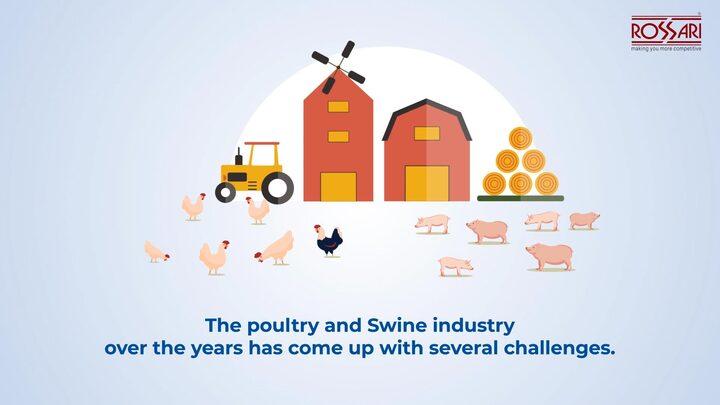
Content sponsored by:
Rossari Biotech Limited
Technological advancement in poultry and livestock enzymes
Published: April 26, 2022
By: Rossari Biotech Limited
The use of enzymes in animal feed was first reported in 1925 (Hervey 1925) but the chemistry of target feed substrate has been understood during the last two decades only. The field of biotechnology has introduced various advancements in enzyme production technology specifically in fermentation and microbiological processes resulting in production of enzymes in affordable range to be used for commercial purpose. The advances also include development of enzymes that are stable during processing of commercial feeds and function optimally in the gastrointestinal tract of the animals.
The poultry industry is the largest user of feed enzymes but a trend for the pig industry to use feed enzymes especially the phytate degrading enzymes has been observed to increase. It has been observed that 90% of broiler diets in some countries (e.g., United Kingdom, Australia, New Zealand, Canada) contain feed enzymes only and on worldwide basis 70% of wheat and barley-based poultry feeds are supplemented with glycanases (xylanases and -glucanases). Over the past decade an increment has been observed for using microbial phytase in poultry and pig diets as a solution for phosphorus pollution from effluents due to intensive animal operations. The ban on the use of meat and bone meal in the European Union is another factor that has accelerated the use of microbial phytases. As a result, microbial phytase has overtaken the glycanases as the primary feed enzyme worldwide. The ultimate aim of using feed enzymes is to improve animal performance through improvements in feed intake, weight gain and feed efficiency.
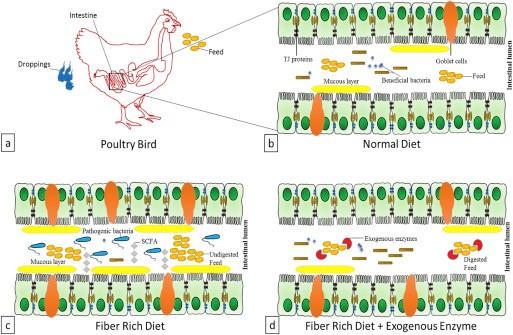
Enzymes are found to work by different mode of action like degradation of specific bonds in ingredients which are not usually hydrolysed by endogenous digestive enzymes, degradation of anti-nutritional factors that lower nutrient digestion or increase digesta viscosity, disruption of endosperm cell wall integrity and the release of nutrients that are entrapped by the cell wall, shift of nutrient digestion to more efficient digestion sites, reductions in endogenous secretions and protein losses from the gut, resulting in reduced maintenance requirements and reduction in the changes occurring in intestinal morphology.

The groups of enzymes targeting non-viscous cereals and non-cereals are the emerging groups of enzymes. Enzymes targeting viscous cereal grains include xylanases and glucanases which is used in wheat and barley-based diets respectively. It is known that the poor nutritional value of wheat and barley is related to their soluble NSP contents. This has two major effects among which first is bacterial deconjugation of bile salts, which is necessary for the emulsification of fats, resulting in lowered fat digestion and second is the negative effect on general gut health. The apparent metabolizable energy (AME) data from the scientific trails suggest that the responses to supplemental xylanase depend greatly on the initial AME of the wheat sample. Historically it has been known that non-viscous grains such as maize and sorghum has high nutrient and energy utilisation capacity by poultry but recent studies deny this case. A considerable variability exists in the AME and starch digestibility of these non-viscous grains which can be improved by supplementation of enzymes targeting non-viscous grain by enhancing activity of amylase. The ban on use of meat and bone meal in Europe indicates that a bigger market will be created for soybean meal and alternative plant-based protein ingredients such as oilseed meals (e.g., canola meal, sunflower meal, palm kernel meal) and grain legumes (e.g., peas, lupins). Most of these ingredients have obvious potential but utilisation is repressed by several nutritional limitations like high fibre or NSP level, resulting in poor nutrient availability. These limitations focus on the need for enzymes targeting cereal feedstuff. Microbial phytases entered the feed market in the early 90’s in Europe.
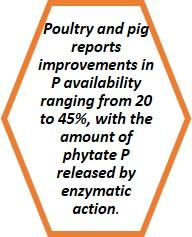
The substrate for microbial phytases is phytic acid [myoinositol 1,2,3,4,5,6-hexakis dihydrogen phosphate] a major storage form of P in plant-derived ingredients. Phytate-bound P in plant ingredients are poorly available to monogastric animals and is reflected in the form of excretion of large amounts of phosphorus in effluent from intensive animal operations. After some reluctance and concerns regarding efficacy, it has now become the most accepted feed enzyme. The effectiveness of phytase in releasing phytate-bound P in diets based on a range of plant derived feedstuffs for utilisation by poultry and pigs has been well observed. Phytase equivalency values to replace 0.1% available P in diets for different classes of animals. With the introduction of new types of phytases (such as bacterial phytases) it is expected that these values may further get lowered. Among the six P units in the phytic acid molecule only two or three are released by the action of microbial phytases within the digestive tract of poultry and pigs for utilisation. Recent studies have shown that bacterial phytases liberates more P in broilers and pigs than fungal phytases, owing to their relative resistance to pepsin activity and high relative activity over a broader pH range. The development of ‘second-generation’ phytases with a greater capacity to hydrolyse dietary phytate will further reduce P excretion and generate greater amino acid or energy responses making phytase more cost effective.

Although feed enzymes have had a significant impact on the poultry industry, we are yet to fully harness the full potential of enzymes and expand their use to other farmed animals. Enzymes that match substrate chemistry and structure variable responses are partly available. Also, in most of the cases the target substrates are poorly defined emphasising the need to understand the chemistry of the target substrates more precisely. The new enzymes developed from bacteria and yeast will improve the efficacy of the enzymes within the gut and such development is already taking place in exogenous enzymes formulation but, they still lose significant amount of activity when processing temperature exceeds 70°C. As a result, enzymes are usually included as liquids, via post-pelleting application systems which is a complex and costly procedure.
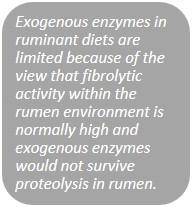
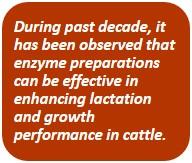
The development of thermostable enzymes will simplify the pre-pelleting application of dry products and promote the use of the enzyme in pelleted diets. The need to prepare enzyme with multiple activities will help in achieving maximal benefits from feed enzyme addition. In other words, there is a need to match enzymes with the substrates in the feed. The combined application of enzymes may result in additive, sub-additive or synergistic effects on nutrient utilisation and animal performance. The cocktail enzymes represent the next generation of feed enzymes as the feed ingredients are complex structures and over the past two decades, feed enzymes have become a well-accepted tool to improve nutrient utilisation. The use of feed enzymes in poultry and pig feeds is expected to increase in the future as the changes in farming style require enzymes to add ‘value’ to feed enzymes and lower their opportunity cost. The key driver of this change is ban on Antibiotic Growth Promoters. The ban in the European Union and different degrees of voluntary withdrawal in other parts of the world on the use of in-feed antibiotics will put extra pressure on the gut health and general health of animals. The feed enzymes, through their effects on improving digestibility and reducing the amount of undigested nutrients reaching the hindgut play a key role in lowering proliferation of harmful species in the gut environment. It clearly implies that exogenous feed enzymes must be part of the ‘package’ being considered in any decision replacing antibiotic growth promoters. The new ingredient entering the feed market like dried distillers’ grains needs enzymes to maximise its utilization. It will be necessary to develop ‘enzyme cocktails’ that can target more than one substrate at a given time. Given that high fibre and NSP levels may be limiting nutrient availability in these ingredients, an especially crucial components of the cocktail will be the enzymes that will target the fibre fraction such as appropriate mannanases, cellulases etc. The major concerns with many available alternative feedstuffs are their relatively low nutrient digestibility and the presence of an array of anti-nutritional factors. These constraints could be overcome, in part, by the addition of exogenous enzymes, provided optimal means of application are found. On the basis of expected changes in future farming techniques the exogenous feed enzymes are expected to play key role. Feed enzyme technology is an active area of research and development, and one can be certain that better forms of enzymes will be developed in the future. In particular, the development of more thermostable enzymes will simplify the pre-pelleting application of dry product and promote the use of the enzyme in pelleted diets. It is also clear that the next generation of enzymes will be those with multiple enzyme activities rather than individual enzymes.
Related topics:
Authors:
Rossari Biotech Limited
Rossari Biotech Limited
Recommend
Comment
Share

Would you like to discuss another topic? Create a new post to engage with experts in the community.


